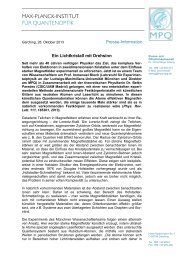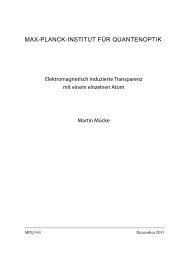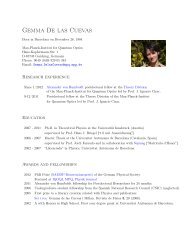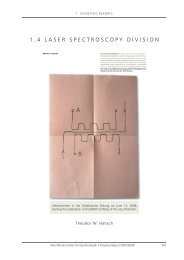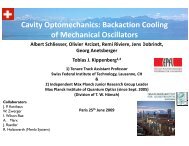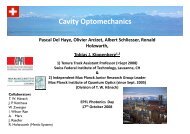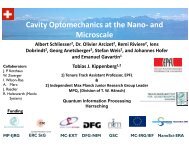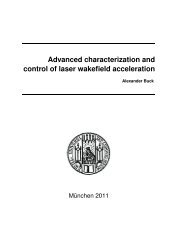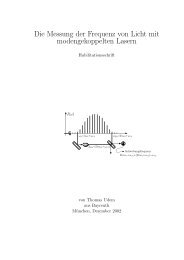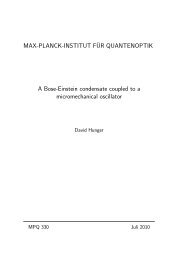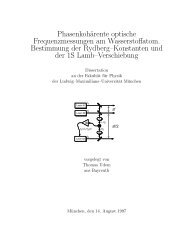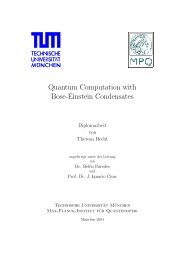Attosecond Control and Measurement: Lightwave Electronics
Attosecond Control and Measurement: Lightwave Electronics
Attosecond Control and Measurement: Lightwave Electronics
You also want an ePaper? Increase the reach of your titles
YUMPU automatically turns print PDFs into web optimized ePapers that Google loves.
770<br />
<strong>Attosecond</strong> Spectroscopy<br />
Femtosecond technology is the result of controlling<br />
the nonlinear polarization of matter with the<br />
amplitude of light. <strong>Control</strong>ling the absorption<br />
<strong>and</strong>/or refractive index in this way has yielded—<br />
along with group delay dispersion control—<br />
femtosecond pulses from laser oscillators by means<br />
of passive mode locking (1). <strong>Measurement</strong> of<br />
the pulses relies on the same physical effect:<br />
control of the nonlinear polarization of matter<br />
by a replica of the pulse in the presence of the<br />
pulse to be characterized (6, 7).<br />
The controlled, well-characterized evolution<br />
of the amplitude envelope <strong>and</strong> carrier-frequency<br />
sweep (chirp) of ultrashort laser pulses permits<br />
measurement (2) <strong>and</strong> control (8) of quantum<br />
transitions on a femtosecond time scale. Reliance<br />
on these cycle-averaged quantities implies that<br />
measurement resolution <strong>and</strong> control speed are<br />
ultimately limited by the carrier wave cycle. The<br />
carrier wave cycle period is about 3 fs in the near<br />
infrared, where low dispersion favors the generation<br />
of the shortest laser pulses.<br />
Toward <strong>Attosecond</strong> Technology:<br />
X-ray–Pump/X-ray–Probe Spectroscopy?<br />
Femtosecond measurement <strong>and</strong> control techniques<br />
utilizing nonlinear material response could,<br />
in principle, be extended into the attosecond time<br />
domain by using intense attosecond pulses of extreme<br />
ultraviolet (XUV) or x-ray light. Unfortunately,<br />
in these regions of the optical spectrum, the<br />
probability of two-photon absorption is prohibitively<br />
low. X-ray–pump/x-ray–probe spectroscopy<br />
<strong>and</strong> x-ray quantum control therefore rely on x-ray<br />
intensities that can be attained only with large-scale<br />
free-electron lasers (9). Even though these sources<br />
are expected to eventually deliver their radiation<br />
in subfemtosecond pulses (10) <strong>and</strong> XUV<br />
sources pumped by large-scale, high energy<br />
lasers have already pushed the frontiers of<br />
nonlinear optics to the range of several tens of<br />
electron volts (11, 12), proliferation of attosecond<br />
technology <strong>and</strong> its widespread applications<br />
call for another approach—one that relies on light<br />
sources suitable for small laboratories.<br />
An Alternative Route: Light-Induced<br />
Electronic Motion Within the Wave<br />
Cycle of Light<br />
The electric field of visible, near-infrared or<br />
infrared (henceforth, referred to collectively as<br />
NIR) laser light, E L(t), exerts a force on electrons<br />
that varies on a subfemtosecond scale. The use of<br />
this gradient for initiating <strong>and</strong> probing the<br />
subsequent dynamics with attosecond timing<br />
precision <strong>and</strong> resolution has led to the emergence<br />
of an attosecond technology that does not rely on<br />
the existence of intense x-ray pulses.<br />
According to theory, strong-field–induced<br />
ionization of atoms is confined to subfemtosecond<br />
intervals near the peaks of the oscillating<br />
NIR field (Fig. 1A), setting a subfemtosecond<br />
electron wave packet yfree(t) free; this prediction<br />
1 . 3 AT T O S E C O N D A N D H I G H - F I E L D P H Y S I C S D I V I S I O N<br />
was recently confirmed by real-time observation<br />
(13). The subfemtosecond ionization process,<br />
locked to the peak of NIR field oscillation with<br />
corresponding precision, may serve as a subfemtosecond<br />
“starter gun” for a wide range of<br />
dynamics (including electronic <strong>and</strong> subsequent<br />
nuclear motion <strong>and</strong> related dynamics of molecular<br />
structure).<br />
The energetic radiation concurrent with opticalfield<br />
ionization in a linearly polarized laser field<br />
(14) provides a means of triggering motion in a<br />
more gentle way, without applying an intense<br />
field. The broadb<strong>and</strong> XUV light building up<br />
during the propagation of the driving pulse<br />
through an ensemble of atoms was predicted to<br />
emerge in a subfemtosecond burst within every<br />
half optical cycle that is sufficiently intense for<br />
ionization (15). In this Review, we focus on these<br />
photonic tools of attosecond technology, noting<br />
that the recolliding electron wave packet itself<br />
can also be used to explore dynamics (16–18).<br />
The electronic (<strong>and</strong> concurrent) phenomena<br />
following the attosecond trigger can be tracked<br />
with comparable resolution with the use of the<br />
generating NIR field, the oscillations of which are<br />
synchronized with the trigger event (tunnel<br />
ionization, recollision, or XUV burst from recollision).<br />
Let us consider an electron ejected during<br />
the unfolding evolution of the system under<br />
scrutiny. In the presence of a linearly polarized<br />
NIR field, outgoing electrons collected along<br />
the direction of the laser electric field EL(t)<br />
(Fig. 1B) suffer a momentum change DpðtÞ ¼<br />
e∫ ∞ t ELðt′Þdt′ ¼ eALðtÞ. Here, e is the charge of<br />
the electron, t is the instant of its emission, <strong>and</strong> A L<br />
(t) is the vector potential of the laser field. This<br />
change varies monotonically within a half wave<br />
cycle of the laser field, mapping the temporal<br />
evolution of the emitted subfemtosecond electron<br />
wave packet to a corresponding final momentum<br />
<strong>and</strong> energy distribution of the emitted electrons.<br />
We recognize here a new embodiment of<br />
the basic concept of streak imaging, with the<br />
streaking controlled by the NIR field in this case.<br />
The electrons can gain or lose an energy of<br />
several electron volts depending on whether they<br />
have been emitted some hundred attoseconds<br />
sooner or later than the peak of the field cycle<br />
(Fig. 1B), endowing this light-field–driven streak<br />
camera with attosecond resolution (19, 20).<br />
The physical concepts <strong>and</strong> mechanisms outlined<br />
above have opened a realistic prospect of<br />
measuring <strong>and</strong> controlling electron dynamics on<br />
an attosecond time scale. However, full exploitation<br />
of the potential offered by this conceptual<br />
framework requires precise control over the applied<br />
laser field.<br />
Steering Electrons with the Electric<br />
Field of <strong>Control</strong>led Light Waves<br />
In a laser pulse comprising many field cycles, the<br />
subfemtosecond electron <strong>and</strong> photon bursts born<br />
in the ionizing field emerge every half cycle,<br />
10 AUGUST 2007 VOL 317 SCIENCE www.sciencemag.org<br />
resulting in a train of subfemtosecond bursts (21).<br />
Its spectrum consists of equidistant lines that<br />
represent high-order odd harmonics of the<br />
driving field (22). The subfemtosecond pulse<br />
train <strong>and</strong> its multicycle driver constitute powerful<br />
tools for controlling <strong>and</strong> tracking electron<br />
dynamics that terminate within the NIR field<br />
oscillation cycle (23–25). The characteristics<br />
of the individual bursts in the train can be difficult<br />
to control <strong>and</strong> measure. Extension of attosecond<br />
control <strong>and</strong> metrology to a wide range of<br />
electronic phenomena (including all those extending<br />
in time over more than half an optical cycle)<br />
calls for the isolation of one to several attosecond<br />
pulses <strong>and</strong> precise control of their properties (26).<br />
Isolation was predicted to be achievable by<br />
manipulating the polarization state (polarization<br />
gating) of the driving field (27) or shortening its<br />
duration to nearly a single cycle of the carrier<br />
wave (28). In fact, intense few-cycle laser pulses<br />
lasting several femtoseconds (1) led to the first<br />
observation of light lasting for less than 1 fs (29).<br />
Full control of the number <strong>and</strong> properties of bursts<br />
isolated, however, requires precise control of the<br />
driving electric-field waveform E L(t).<br />
Intense few-cycle laser pulses with controlled<br />
waveform (4)—along with careful b<strong>and</strong>pass filtering<br />
of the highest-energy (cutoff) harmonics—<br />
have indeed permitted the reproducible generation<br />
of single <strong>and</strong> twin subfemtosecond pulses with<br />
cosine- <strong>and</strong> the sine-shaped electric field waveforms,<br />
respectively, as well as their reliable measurement<br />
by means of attosecond streaking (30, 31)<br />
(fig. S1). The series of streaked electron spectra<br />
shown in Fig. 1C yields complete information<br />
about the driving laser field <strong>and</strong> allows determination<br />
of the temporal shape, duration, <strong>and</strong> a<br />
possible chirp of the emitted subfemtosecond<br />
XUV pulse (Fig. 1D) as well as the degree of<br />
its synchronism with its driver (31–33). These<br />
experiments reveal that few-cycle light with<br />
controlled waveform permits reproducible generation<br />
<strong>and</strong> complete characterization of subfemtosecond<br />
light. Owing to the attosecond<br />
synchronism between them, these tools allow<br />
attosecond metrology without the need for highintensity<br />
x-rays.<br />
<strong>Lightwave</strong> <strong>Electronics</strong>: Versatile<br />
Technology for <strong>Control</strong> <strong>and</strong> Chronoscopy<br />
on the Electronic Time Scale<br />
<strong>Control</strong>led light fields permit control of microscopic<br />
electric currents at the atomic scale just as<br />
synthesized microwave fields permit control of<br />
currents at the mesoscopic scale in semiconductor<br />
chips. By analogy to microwave electronics, we<br />
propose to name this new technology lightwave<br />
electronics. In marked contrast with previous<br />
quantum control through controlling transitions<br />
between quantum states with the amplitude <strong>and</strong><br />
frequency of light (8), lightwave electronics gives<br />
way to controlling dynamics directly by the force<br />
that the electric field of intense light exerts on<br />
174 Max-Planck-Institut für Quantenoptik • Progress Report 2007/2008<br />
on November 12, 2007<br />
www.sciencemag.org<br />
Downloaded from



